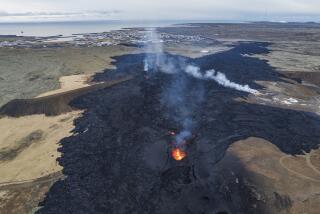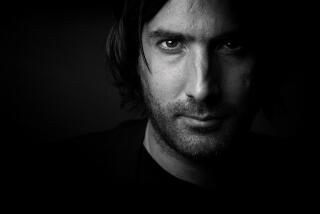Iceland is steamed
- Share via
In December, reports surfaced that then-Treasury Secretary Henry M. Paulson was nervous. Without a Wall Street bailout package, he reportedly warned members of Congress, civil unrest might become so widespread that martial law would have to be imposed. That same month, International Monetary Fund Managing Director Dominique Strauss-Kahn warned of the risk of worldwide riots in connection with the economic collapse.
What really worried them, I suspect, was not that people would throng the streets, or even that those people might demand radical social and political change. The real concern was that the rioters might achieve some of their demands.
Take the example of Iceland, the first but surely not the last country to go bankrupt.
While the United States was inaugurating its first African American president, Icelanders were besieging their Parliament, demanding change in the wake of economic meltdown. Dramatic video of the scene shows drummers pounding out a tribal beat, the flare and boom of tear-gas canisters being fired, scores of helmeted police behind transparent plastic shields, a huge bonfire in front of the stone building, its hot light flickering on the gray walls through the long winter night. People, silhouetted against the blaze, beat pots and pans in what was dubbed the “Saucepan Revolution.” Five days later, the government dominated by the neoliberal Independent Party collapsed.
Iceland’s interim government, built from a coalition of the Left-Green Movement and the Social Democratic Alliance, is at least as different from the old one as the Obama administration is from the Bush administration. In power only until the April 25 elections, the caretaker government, headed by Johanna Sigurdardottir, takes on the formidable task of stabilizing and steering a country that has the dubious honor of being the first to fall in the current global crash.
A changed people
Iceland’s currency, the krona, has collapsed. The debt incurred by its banks, deregulated in the mid-1990s, is 10 times larger than the country’s gross domestic product. Iceland’s citizens have lost most of their savings and face unpayable debts and mortgages; inflation and unemployment are skyrocketing. But just as the new government is different than the old, the Icelandic people have changed too, becoming furious and engaged where they were once acquiescent and uninvolved.
Iceland is a harsh, beautiful rock dangling from the Arctic Circle like a jewel on a pendant. Bereft of mineral resources, too far north for much in the way of agriculture, it had some fish, some sheep and, of late, some geothermal and hydropower energy and a few small industries, along with a highly literate populace whose fierceness was apparently only temporarily dormant during the era of borrowing to spend. The people I’ve talked to since the troubles are both exultant that they have reclaimed their country and terrified about the stark poverty facing them.
Once a fairly egalitarian nation, Iceland’s boom created a new class of the super-wealthy whose private jets landed at the airport in downtown Reykjavik and whose yachts, mansions and other excesses sometimes made the news, as did charges of corruption in business and in the government that countenanced that business. It wasn’t corruption, however, that did in the Icelandic economy. It was government-led recklessness and deregulation. The public tolerated privatization and giveaways of everything from their medical histories and DNA to their fishing industry and wilderness, and a host of subsidiary indignities.
Take, for example, the once-enormously wealthy Baugur Group run by the father-and-son team of Jon Asgeir Johannesson and Johannes Jonsson. Their Bonus stores (with the distinctive hot-pink piggy-bank logo) had managed to create a near-monopoly on supermarkets in Iceland. They provided cheap avocados from South Africa and mangoes from Brazil, but they’d apparently decided that selling fresh fish was impractical, so in the fishing capital of the Atlantic, most of the people outside the center of the capital had no choice but to eat frozen fish.
Icelanders also ate a lot of American-style arguments in favor of deregulation and privatization, or looked the other way while their leaders did. Fortune magazine blamed one man, David Oddsson, prime minister from 1991 to 2004, for much of this privatization: “It was Oddsson who engineered Iceland’s biggest move since [joining] NATO: its 1994 membership in a free-trade zone called the European Economic Area. Oddsson then put in place a comprehensive economic transformation program that included tax cuts, large-scale privatization and a big leap into international finance. He deregulated the state-dominated banking sector in the mid- 1990s, and in 2001, he changed currency policy to allow the krona to float freely rather than have it fixed against a basket of currencies including the dollar. In 2002, he privatized the banks.”
By the mid-1990s, Iceland had, through dicey finance and lots of debt, launched its journey to becoming one of the world’s most affluent societies. Fortune continues: “But the principal fuel for Iceland’s boom was finance and, above all, leverage. The country became a giant hedge fund, and once-restrained Icelandic households amassed debts exceeding 220% of disposable income -- almost twice the proportion of American consumers.”
The first of the hedge-fund-cum-nation’s three main banks, Glitnir, fell on Sept. 29 of last year. A week later the value of the krona fell by nearly a third. Two large banks, Landsbanki and Kaupthing, collapsed later that week. Britain snarled when Landsbanki froze British citizens’ Internet savings accounts and used anti-terrorism laws to seize the bank’s assets, incidentally reclassifying Iceland as a terrorist nation and pushing its economy into a faster tailspin.
What now?
That’s the point at which Icelanders began to get angry -- at Britain, but even more at their own government. The crashing country developed one growth industry: bodyguards for politicians, in a country where every pop star and prime minister had once roamed freely in public. An Icelandic friend wrote me: “Eggs were being thrown at the Central Bank. Such emotional protests have not been seen since the early part of the 20th century, although then people were too poor to throw eggs.”
Soon they were also being thrown at Prime Minister Geir Haarde, whose policies were very much an extension of Oddsson’s.
Where Iceland goes from here is hard to foresee. But as Icelandic writer Haukar Mar Helgason put it in the London Review of Books last November: “There is an enormous sense of relief. After a claustrophobic decade, anger and resentment are possible again. It’s official: capitalism is monstrous. Try talking about the benefits of free markets and you will be treated like someone promoting the benefits of rape. Honest resentment opens a space for the hope that one day language might regain some of its critical capacity, that it could even begin to describe social realities again.”
The big question may be whether the rest of us, in our own potential Icelands, picking up the check for the captains of industry’s decade of recklessness, will be resentful enough and hopeful enough to say that unfettered capitalism has been monstrous, not just when it failed but when it succeeded. Let’s hope that we’re imaginative enough to concoct real alternatives. Iceland has no choice but to lead the way.
Writer Rebecca Solnit spent several months in Iceland last year. Her book on disaster and civil society, “A Paradise Built in Hell,” will be out later this year. A longer version of this article appears at tomdispatch.com.
More to Read
Sign up for Essential California
The most important California stories and recommendations in your inbox every morning.
You may occasionally receive promotional content from the Los Angeles Times.













